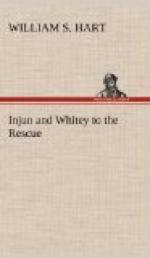“You mean Mart Cooley,” said another ranchman. “There was only one of him. But he done two years at Deer Lodge, an’ nobody’s ever seen him since.”
“Guess again,” Walt replied. “I heard o’ him. He’s been down in the Chinook Country. An’ what’s more I’ve got word o’ Mart, an’ he’s comin’ here t’night.”
Walt’s words caused a sensation, and while it is subsiding I may as well explain that in those frontier days there was a vast stretch of mesa or prairie known as the Chinook Country, because of the unseasonable, warm, and soothing winds that blew there. You may have read Bill Jordan’s tale about these winds, in the first Injun and Whitey story. They would melt the snow, and cause the cowmen to start out their feeding herds, only to be caught by the northers, that brought the bitter, perishing cold, and killed the stock by thousands. On account of this uncertain condition the Chinook Country was avoided in the early days, save by those who located there for reasons—which no one was ever known to question. And in this desolate place Walt Lampson had heard of Mart Cooley, and from there he had lured him to the Star Circle Ranch.
Whitey waited, almost breathless, for the thrill that was to come at his first sight of the “bad man” of the West; the “two-gun man” who has long since passed into history, but was then a factor of the troublous times.
And you might like to hear a word or two about the ways he handled his gun, for he had more than one way. But first, the way he didn’t handle it. Ordinarily, when you are shooting at a mark with a pistol, you cock the weapon, close one eye, and gaze along the barrel with the other until the sight is in line with the mark, and, holding the pistol steady, pull the trigger. That was what the gunman didn’t do.
He sighted his weapon much as you throw a stone—by judging with his eye. He filed off the sight, so it wouldn’t catch in the holster And he didn’t use the trigger at all. That, too, could be taken off. Let us say that he was using both guns. He drew them from their holsters with marvelous speed. As he did so, he flipped back the hammers with his thumbs, and allowed them to fall on the cartridges, thus firing the first shots. The remaining shots were fired by working the hammers in the same way, and the actions caused an up-and-down movement of the guns. Seems a funny way to fire a revolver, doesn’t it? But it wasn’t funny for the man who was in front of the bad man.
He had another way of not leveling the gun at all, but firing from his hip, the revolver being held there, and the hammer worked with the thumb. Another and very expert way was to fire from the holster, not taking the gun out at all. This was remarkably quick and deadly.
But the strangest way of all, that was sometimes used at close quarters, was called “fanning.” The gun was held at the hip, the first shot fired with the thumb-hammer movement. The gunman spread out the thumb and fingers of his other hand, and quickly drawing them across the hammer, one after another, they fired the shots with lightning rapidity. You would be surprised at the speed with which shots can be fired in this way. Try it sometime—with an empty gun.




